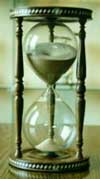
Vol. IV, No. 11, November 2004
- Editor's Corner
- Old MacDonald Had a Booming Agritainment Business (e-i-e-i-o)
- Family Pizza Buffet/Entertainment Center Under Design
- Cultural Shift in the Perception and Use of Leisure Time
- Foundations Entertainment University
- Birthday Party Newsletter
- Cherry-Crest Farm
- Food Network's Unwrapped Show Broadcast Date Set
- Entertainment Spending Increases
- Recently Published Articles
- Soft Foam Play Areas Pose Safety Hazard
- Chuck E. Cheese's Starts Fundraising Program
Cultural Shift in the Perception and Use of Leisure Time
Earlier this year I was talking with Jim Kessler, who owns the oldest continuously operating and most successful laser tag facility, Lasertron Interactive Entertainment Center in the Buffalo, New York, metro area. He told me how his facility is now taking advance reservations for laser tag, even for the middle of a Saturday afternoon, and how it had increased his business. Jim explained that he made the change as he realized many families had only limited blocks of time between one child's music lesson and another child's baseball game later the same day and would not come to Lasertron between the lesson and game unless they knew they would be able to play a game of laser tag. Their available leisure time was too valuable to potentially waste if they wouldn't have a chance to play a game of laser tag before they had to leave for the baseball game.
Jim is definitely on to something that addresses a major cultural shift occurring both in the perception and use of leisure time.
Interestingly, while there is a common perception that we have less leisure time than in the past, studies show that today we have just as much spare time as families had back in the days of Ozzie and Harriet - about 30 hours a week. The perception of less available time today appears to be due to two possible factors:
 There
are far more choices for how we can spend our leisure time. People want
to squeeze many activities into the leisure time they have, making it seem
like there is less time today to enjoy leisure activities than there was
in the past.
There
are far more choices for how we can spend our leisure time. People want
to squeeze many activities into the leisure time they have, making it seem
like there is less time today to enjoy leisure activities than there was
in the past.- In the past, leisure came in big blocks of time, time you could use to garden, read a book, take long walks. Today, we see our lives more like a television schedule, broken down into time increments that need to be filled. Today, everything is scheduled. We tend to take our 30 hours of leisure time, break it into small increments of an hour or so, and schedule it amongst our other activities throughout the week. Our 30 hours of free time that was once concentrated on the weekend is now scattered in small packets of time throughout the entire week. One result is the leisure time has discrete scheduled beginning and ending times, perhaps making the leisure seem more rushed.
So, for a family, there might be an hour and a half of available free time after one child's soccer practice on Monday afternoon, one hour after school on Wednesday night, two hours Friday evening, an hour and a half before and two hours after the Saturday baseball game, two hours during Saturday dinner time - you get the picture. It's no longer taking a Saturday drive to some leisure attraction where the family might spend the entire day.
Even the longer blocks of leisure time we have are shorter. Instead of full one- or two-week vacations, we now often take two- and three-day vacations. Today, more than half of all holiday trips are weekend trips.
 Another
example of how our use of time has changed is when a parent has several hours
free in the afternoon to take her children to a play facility, but has an
important business call scheduled midway during that time period. With cell
phones, the parent does not have to sacrifice time with the child because
of a conflict with the business call. Mom can multi-task for 15 minutes while
she takes the call and still watch her child having fun. Today, you even find
many mom-epreneurs in McDonald's PlayPlaces watching their children
play while they answer e-mails on their portable computers using the restaurant's
Wi-Fi service.
Another
example of how our use of time has changed is when a parent has several hours
free in the afternoon to take her children to a play facility, but has an
important business call scheduled midway during that time period. With cell
phones, the parent does not have to sacrifice time with the child because
of a conflict with the business call. Mom can multi-task for 15 minutes while
she takes the call and still watch her child having fun. Today, you even find
many mom-epreneurs in McDonald's PlayPlaces watching their children
play while they answer e-mails on their portable computers using the restaurant's
Wi-Fi service.
Time is no longer a vacuum that need not be filled. The perceived scarcity of time, desire to do more than available leisure time might allow, and the necessity to plan every minute of our waking days is upping the ante for each leisure decision. Our culture now so values the productive use of time that perceived waste of time is almost considered a sin. A bad movie is no longer a bad movie. It represents a lost opportunity in terms of the enjoyment you could have had during that time. The bar has been raised for the expectation level of leisure experiences. The leisure experience better be great if we are going to make an investment of our limited and valuable leisure time.
To make sure we don't risk wasting our leisure time, we now do more research in making our entertainment decisions. We use the internet to research them. We talk to friends and share our experiences, both good, mediocre and bad. Today, word-of-mouth recommendations or warnings are even more valuable than in the past.
This change in the perception, use and value of leisure time presents both challenges and opportunities for the location-based entertainment (LBE) industry when it comes to attracting contemporary families. Jim Kessler, as an astute LBE operator, found a way to shift his business practices to meet the needs of modern families by assuring them maximum utilization of their pre-scheduled small increments of leisure time while in his facility. McDonald's added Wi-Fi so business people, including mom-epreneurs, could multi-task while eating and sometimes going out with their children. Restaurants that once did not take reservations are allowing you to call ahead when you leave home to be placed on the waiting list. Theme parks are selling premium tickets that allow you to bypass the masses in the queue to get right to the ride. Our new way of valuing our fragmented leisure time probably explains the continued popularity of cinemas, especially the mega-plexes, despite the growth of home entertainment centers, video and DVD rentals and premium television cable channel. Movies play at scheduled times that can be planned into available leisure hours, and they're in two-hour increments. And at the mega-plex cinemas, with 16 to 24 different screens, even if the show you planned on is sold out, there are plenty of alternative options to fill the scheduled leisure time slot.
This change in the nature and value of leisure time is an opportunity for community-based LBEs, as they are close to where potential guests live, so they can be visited within the confines of today's smaller fragmented chunks of leisure time. However, that alone doesn't mean that a community-based LBE can expect to gain a greater piece of the leisure time pie. LBEs have to look at modifying their practices, much as Jim Kessler did, to assure the guests that when they arrive, they will be able to enjoy the activities they are coming for. Likewise, offering multi-dimensional leisure opportunities, such as McDonald's does by allowing mom-epreneurs (and dad-epreneurs, as well) to multi-task will increase the perceived value and attractiveness of the leisure offering.
The changing nature of leisure time is also contributing to the appeal of edutainment offerings. You can look at edutainment as a multi-task leisure experience. Having fun and learning at the same time has twice the value as spending your valuable leisure time on only one alone. And well-designed children's edutainment (discovery play) centers that also offer moms a café with good quality java and food, Wi-Fi and a pleasant seating area increase the value even more. Now the children are having fun and learning while moms can sit with their friends and socialize, check e-mail and have some java and even a good meal. Add in some enrichment opportunities for moms, and the perceived leisure equation gets even better.
Yes, contemporary consumers view and experience time completely differently than did past generations. To continue to capture a share of today's leisure time market, LBEs need to evolve to tailor their offerings into this new time paradigm.
Editor's note: In last month's issue, we discussed another significant societal shift from material to experiential spending that likewise is impacting LBEs (see No Longer "a Material Girl in a Material World"). This shift to experiential spending is increasing the number of leisure opportunities for consumers, so re-inventing LBEs within the new time paradigm becomes even more important.
Vol. IV, No. 11, November 2004
- Editor's Corner
- Old MacDonald Had a Booming Agritainment Business (e-i-e-i-o)
- Family Pizza Buffet/Entertainment Center Under Design
- Cultural Shift in the Perception and Use of Leisure Time
- Foundations Entertainment University
- Birthday Party Newsletter
- Cherry-Crest Farm
- Food Network's Unwrapped Show Broadcast Date Set
- Entertainment Spending Increases
- Recently Published Articles
- Soft Foam Play Areas Pose Safety Hazard
- Chuck E. Cheese's Starts Fundraising Program


